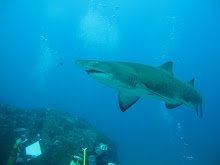Friday, March 5, 2010
Big Seal Rock, 27th February 2010
Two weeks of southerly winds and swell finally delivered clear waters for GLUG, and Saturday 27th February, six members headed out to Big Seal Rock, now classified as Sanctuary Zone in the Port Stephens - Great Lakes Marine Park. The site is also well known for it's Grey Nurse Sharks, and listed as a Critical Habitat Site for these endangered animals. GLUG dived here 12 months ago with great conditions, and saw about 70 sharks in the Eastern Gutter on that occasion, but that was nothing compared to the treat in store for them today.
Visibility was good, about 20m, and the water was a balmy 23 degrees. Six divers headed down the line and were greeted by a pair of Lord Howe Butterfly fish at the bottom, along with the usual suspects, Mado, Sweep, Crimson-banded wrasse and One-spot pullers. We took a wide berth around the rock, where Beardies, Cardinalfish and Eastern Wirrah darted in and out of crevices. As we rounded the rock into the main gutter, we were literally gob-smacked by the sheer numbers of sharks parading up and down the gutter. I counted over 120 sharks over the course of the dive, and we didn't cover the entire length of the gutter. Sharks ranged from just over 1m in size (juveniles) to solid 3m seniors. There were a lot of fat females, many with scratch marks around their faces, one with a large chunk out of her head. There were also a lot of discarded teeth on the sea floor. Sharks were mostly just swimming up and down the gutter, but a couple were observed rolling around in the gravel, one was seen eating a fish, and a couple were very inquisitive about what we were doing in their gutter, swimming close enough for divers to touch them as they swam passively past. At one point, I had sharks all around me, above, below and on either side of me. Divers with cameras took as many photos as possible, trying to get clear shots of the sharks flanks for the "Spot a Shark" program, and those with slates documented the other (abundant) fish life present.
Yellow-tailed Kingfish swam along with the sharks, while Comb Wrasse cheekily harassed divers as they watched the parade with fascination. There were also many wobbegongs present, both spotted and ornate; Snapper, Bream, masses of Bullseyes, at least four Numbrays, Neon and Immaculate Damsels, Girdled Parmas, Red and Blue Morwongs, Moorish Idols, and six-spine Leatherjackets.
Divers noted two sharks with hooks, one in its gills, the other in it's mouth. They also collect one 6oz sinker and one plastic lure, both of which did not appear to be fresh debris.
DIve time was 35minutes at 25m, and all divers were buzzing when they surfaced for a break and a cuppa before re-entering on the western side of the island for dive two.
There is one small grotto on the western side of the island where sharks hang in smaller numbers. Being shallower, GLUG completed their Marine Debris Survey and I ran a 50m Reef Life Survey. THere were so many fish present, I had trouble counting them, particularly the One-spot pullers. I saw a stack of Yellow-tailed Kingfish, including one very fat 75cm individual. Three sharks swam across my transect, I had a stack of bream, goatfish, wrasse, and red morwongs. The substratum was a boulder field, thick with Black Urchins that kept me very busy counting.
The Debris Survey turned up 3 old 6oz sinkers, and some debris in the grotto (fishing line) that was left so as not to disturb the sharks. An old listening station tyre was also observed.
Subscribe to:
Comments (Atom)



